Deck 50: An Introduction to Ecology
Question
Question
Question
Question
Question
Question
Question
Question
Question
Question
Question
Question
Question
Question
Question
Question
Question
Question
Question
Question
Question
Question
Question
Question
Question
Question
Question
Question
Question
Question
Question
Question
Question
Question
Question
Question
Question
Question

Unlock Deck
Sign up to unlock the cards in this deck!
Unlock Deck
Unlock Deck
1/38
Play
Full screen (f)
Deck 50: An Introduction to Ecology
1
Wetlands are standing bodies of freshwater,just like lakes and ponds.However,wetlands are different from lakes and ponds because _____.
A)wetlands have shallow water
B)wetlands have emergent vegetation
C)wetlands have oxygen-poor water
D)wetlands have shallow water and emergent vegetation
E)wetlands have emergent vegetation and oxygen-poor water
A)wetlands have shallow water
B)wetlands have emergent vegetation
C)wetlands have oxygen-poor water
D)wetlands have shallow water and emergent vegetation
E)wetlands have emergent vegetation and oxygen-poor water
D
2
In the limnetic zone,you are most likely to find which organism?
A)lobster
B)halibut
C)pike
D)clam
A)lobster
B)halibut
C)pike
D)clam
C
3
Which abiotic factor would have the most significant physiological effect on migrating salmon?
A)water solute content
B)competition for resources
C)ambient temperature
D)human-built structural interferences
A)water solute content
B)competition for resources
C)ambient temperature
D)human-built structural interferences
A
4
Which of the following statements regarding turnover is true?
A)In fall turnover,dense water at 4°C sinks and disturbs sediments in the benthic zone.
B)In fall turnover,dense water at 4°C rises and disturbs sediments in the benthic zone.
C)The surface water gets to 4°C only by cooling.
D)Fall turnovers and spring turnovers are exactly the same.
A)In fall turnover,dense water at 4°C sinks and disturbs sediments in the benthic zone.
B)In fall turnover,dense water at 4°C rises and disturbs sediments in the benthic zone.
C)The surface water gets to 4°C only by cooling.
D)Fall turnovers and spring turnovers are exactly the same.

Unlock Deck
Unlock for access to all 38 flashcards in this deck.
Unlock Deck
k this deck
5
In deep water,which of the following abiotic factors would most limit productivity?
A)temperature
B)light availability
C)solute concentration
D)all of the above
A)temperature
B)light availability
C)solute concentration
D)all of the above

Unlock Deck
Unlock for access to all 38 flashcards in this deck.
Unlock Deck
k this deck
6
Figure 50.2
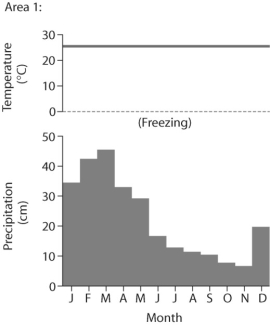
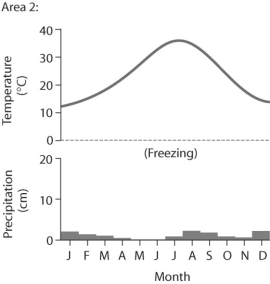
Based on the data in Figure 50.2,which of the following statements is true?
A)Area 1 could be called a boreal forest.
B)Area 2 could be called a temperate grassland.
C)Area 1 could be called a tropical wet forest.
D)Area 2 could be tundra.


Based on the data in Figure 50.2,which of the following statements is true?
A)Area 1 could be called a boreal forest.
B)Area 2 could be called a temperate grassland.
C)Area 1 could be called a tropical wet forest.
D)Area 2 could be tundra.

Unlock Deck
Unlock for access to all 38 flashcards in this deck.
Unlock Deck
k this deck
7
Which of the following terms does not describe aspects of how much plants in a biome grow?
A)productivity
B)net primary productivity
C)aboveground biomass
D)photosynthetic quotient
A)productivity
B)net primary productivity
C)aboveground biomass
D)photosynthetic quotient

Unlock Deck
Unlock for access to all 38 flashcards in this deck.
Unlock Deck
k this deck
8
A fish swimming into a bog environment in Ohio would likely have which of the following as its greatest physiological challenge?
A)The low oxygen content would make it difficult for the fish to swim aerobically.
B)The low nitrogen content would make it difficult for the fish to synthesize proteins.
C)The high temperature would stress the fish by denaturing its proteins.
D)The high water flow would make the fish expend more energy.
E)The high methane content would make respiration difficult.
A)The low oxygen content would make it difficult for the fish to swim aerobically.
B)The low nitrogen content would make it difficult for the fish to synthesize proteins.
C)The high temperature would stress the fish by denaturing its proteins.
D)The high water flow would make the fish expend more energy.
E)The high methane content would make respiration difficult.

Unlock Deck
Unlock for access to all 38 flashcards in this deck.
Unlock Deck
k this deck
9
Figure 50.1
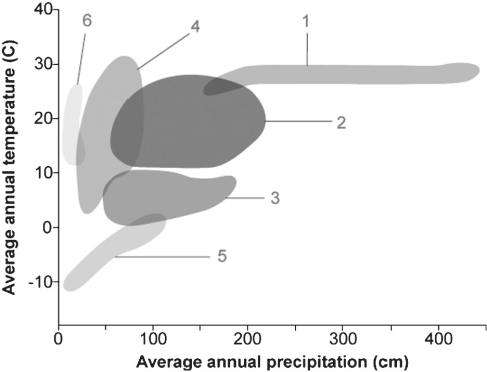
In Figure 50.1,which number would designate the arctic tundra biome?
A)2
B)3
C)4
D)5
E)The arctic tundra is not designated by a number in Figure 50.1.

In Figure 50.1,which number would designate the arctic tundra biome?
A)2
B)3
C)4
D)5
E)The arctic tundra is not designated by a number in Figure 50.1.

Unlock Deck
Unlock for access to all 38 flashcards in this deck.
Unlock Deck
k this deck
10
Figure 50.3
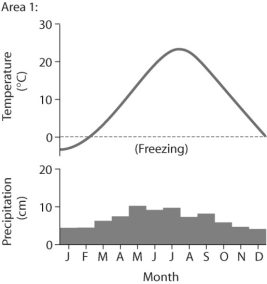

Based on the data in Figure 50.3,which of the following statements is false?
A)Area 1 has more average precipitation than Area 2.
B)Area 1 has a higher average temperature than Area 2.
C)Both areas have low variation in monthly precipitation.
D)Area 2 has a lower annual temperature variation compared to Area 1.


Based on the data in Figure 50.3,which of the following statements is false?
A)Area 1 has more average precipitation than Area 2.
B)Area 1 has a higher average temperature than Area 2.
C)Both areas have low variation in monthly precipitation.
D)Area 2 has a lower annual temperature variation compared to Area 1.

Unlock Deck
Unlock for access to all 38 flashcards in this deck.
Unlock Deck
k this deck
11
A fish swimming into an estuary from a river would have which of the following as its greatest physiological challenge?
A)The high water flow would make the fish expend more energy.
B)The low oxygen content would give the fish difficulty in swimming aerobically.
C)The temperature change would stress the fish by denaturing its proteins.
D)The change in water solute content would challenge the osmotic balance of the fish.
E)The flux of nutrients washing into the estuary would give the fish difficulty in swimming aerobically.
A)The high water flow would make the fish expend more energy.
B)The low oxygen content would give the fish difficulty in swimming aerobically.
C)The temperature change would stress the fish by denaturing its proteins.
D)The change in water solute content would challenge the osmotic balance of the fish.
E)The flux of nutrients washing into the estuary would give the fish difficulty in swimming aerobically.

Unlock Deck
Unlock for access to all 38 flashcards in this deck.
Unlock Deck
k this deck
12
The specific abiotic factors defining a biome are _____.
A)maximum annual temperature and moisture levels
B)average annual temperature and moisture levels
C)annual variation in temperature and precipitation
D)maximum annual temperatures,moisture levels,and average annual temperature
E)average annual temperature,moisture levels,and annual variation in temperature and precipitation
A)maximum annual temperature and moisture levels
B)average annual temperature and moisture levels
C)annual variation in temperature and precipitation
D)maximum annual temperatures,moisture levels,and average annual temperature
E)average annual temperature,moisture levels,and annual variation in temperature and precipitation

Unlock Deck
Unlock for access to all 38 flashcards in this deck.
Unlock Deck
k this deck
13
Which of the following statements regarding temperate grasslands is false?
A)Prairie fires can result from lightning strikes.
B)Grassland soils are not very fertile.
C)Grasslands are lower in productivity than tropical forest communities.
D)Grasslands have too little precipitation to support abundant tree growth.
A)Prairie fires can result from lightning strikes.
B)Grassland soils are not very fertile.
C)Grasslands are lower in productivity than tropical forest communities.
D)Grasslands have too little precipitation to support abundant tree growth.

Unlock Deck
Unlock for access to all 38 flashcards in this deck.
Unlock Deck
k this deck
14
A fish species known for its success in the aphotic zone would likely not have which of the following characteristics?
A)symbioses with photosynthetic organisms
B)highly developed chemoreception
C)adaptations for burrowing
D)adaptations for sit-and-wait predation
A)symbioses with photosynthetic organisms
B)highly developed chemoreception
C)adaptations for burrowing
D)adaptations for sit-and-wait predation

Unlock Deck
Unlock for access to all 38 flashcards in this deck.
Unlock Deck
k this deck
15
Figure 50.1

In Figure 50.1,which number would designate the biome with the highest variation in annual precipitation?
A)1
B)2
C)3
D)4

In Figure 50.1,which number would designate the biome with the highest variation in annual precipitation?
A)1
B)2
C)3
D)4

Unlock Deck
Unlock for access to all 38 flashcards in this deck.
Unlock Deck
k this deck
16
Figure 50.3


Based on the data in Figure 50.3,which of the following statements is true?
A)The data from Area 1 describes a subtropical desert.
B)The data from Area 2 describes an arctic tundra.
C)The data from Area 1 describes a tropical wet forest.
D)The data from Area 2 describes a boreal forest.


Based on the data in Figure 50.3,which of the following statements is true?
A)The data from Area 1 describes a subtropical desert.
B)The data from Area 2 describes an arctic tundra.
C)The data from Area 1 describes a tropical wet forest.
D)The data from Area 2 describes a boreal forest.

Unlock Deck
Unlock for access to all 38 flashcards in this deck.
Unlock Deck
k this deck
17
Figure 50.1

Which of the following biomes has the highest variation in annual temperature?
A)subtropical deserts
B)arctic tundra
C)temperate forests
D)temperate grasslands
E)boreal forests

Which of the following biomes has the highest variation in annual temperature?
A)subtropical deserts
B)arctic tundra
C)temperate forests
D)temperate grasslands
E)boreal forests

Unlock Deck
Unlock for access to all 38 flashcards in this deck.
Unlock Deck
k this deck
18
Figure 50.2


Based on the data in Figure 50.2,which of the following statements is false?
A)Area 1 has more average precipitation than Area 2.
B)Area 1 would be considered a desert because of its high average temperature.
C)Area 2 would be considered a desert because of its low average precipitation.
D)Area 2 has a large annual temperature variation.


Based on the data in Figure 50.2,which of the following statements is false?
A)Area 1 has more average precipitation than Area 2.
B)Area 1 would be considered a desert because of its high average temperature.
C)Area 2 would be considered a desert because of its low average precipitation.
D)Area 2 has a large annual temperature variation.

Unlock Deck
Unlock for access to all 38 flashcards in this deck.
Unlock Deck
k this deck
19
Which level of ecological study focuses the most on abiotic factors?
A)speciation ecology
B)population ecology
C)community ecology
D)ecosystem ecology
E)None of the above focuses on abiotic factors.
A)speciation ecology
B)population ecology
C)community ecology
D)ecosystem ecology
E)None of the above focuses on abiotic factors.

Unlock Deck
Unlock for access to all 38 flashcards in this deck.
Unlock Deck
k this deck
20
The carnivorous pitcher plant is successful in bog habitats because _____.
A)it can tolerate lack of oxygen in the bog water
B)it can tolerate the high acidity of the bog water
C)it has a strategy to get nitrogen,which gives it a competitive advantage
D)it can gain oxygen in an unusual way
A)it can tolerate lack of oxygen in the bog water
B)it can tolerate the high acidity of the bog water
C)it has a strategy to get nitrogen,which gives it a competitive advantage
D)it can gain oxygen in an unusual way

Unlock Deck
Unlock for access to all 38 flashcards in this deck.
Unlock Deck
k this deck
21
Theoretically,which would be the most effective way to disrupt a Hadley cell?
A)Remove all equatorial moisture and convection.
B)Extensively water the deserts.
C)Heat the poles.
D)Shift the Sun to apply direct rays 30 degrees south latitude.
A)Remove all equatorial moisture and convection.
B)Extensively water the deserts.
C)Heat the poles.
D)Shift the Sun to apply direct rays 30 degrees south latitude.

Unlock Deck
Unlock for access to all 38 flashcards in this deck.
Unlock Deck
k this deck
22
What would happen to the seasons if the Earth were tilted 35 degrees off its orbital plane instead of the usual 23.5 degrees?
A)The seasons would disappear.
B)Winters and summers would be more severe.
C)Winters and summers would be less severe.
D)The seasons would be shorter.
A)The seasons would disappear.
B)Winters and summers would be more severe.
C)Winters and summers would be less severe.
D)The seasons would be shorter.

Unlock Deck
Unlock for access to all 38 flashcards in this deck.
Unlock Deck
k this deck
23
Which is a likely biotic factor limiting songbird distribution in Hawaii to alpine habitats?
A)temperature
B)oxygen content
C)moisture
D)insects causing fatal diseases in songbirds at lower altitudes
A)temperature
B)oxygen content
C)moisture
D)insects causing fatal diseases in songbirds at lower altitudes

Unlock Deck
Unlock for access to all 38 flashcards in this deck.
Unlock Deck
k this deck
24
What is the main difference between climate and weather?
A)Weather typically describes a larger area than climate.
B)Climate typically describes longer-term conditions.
C)Climate typically describes shorter-term conditions.
D)Weather includes temperature and climate does not.
E)Climate is primarily a term used by ecologists;weather is primarily a term used by the general public.
A)Weather typically describes a larger area than climate.
B)Climate typically describes longer-term conditions.
C)Climate typically describes shorter-term conditions.
D)Weather includes temperature and climate does not.
E)Climate is primarily a term used by ecologists;weather is primarily a term used by the general public.

Unlock Deck
Unlock for access to all 38 flashcards in this deck.
Unlock Deck
k this deck
25
Cheatgrass has been able to invade dry,temperate grasslands and the arid,shrub-dominated habitats (sage-steppe)of North America.Which of the following is not a reason for this?
A)Cheatgrass is an annual,so there are seeds in the ground ready to grow any year.
B)Cheatgrass is somewhat fire tolerant.
C)Cheatgrass promotes fire frequency and increases fire intensity.
D)Cheatgrass competes successfully with bunchgrasses for water and nutrients.
E)All of the above are valid reasons.
A)Cheatgrass is an annual,so there are seeds in the ground ready to grow any year.
B)Cheatgrass is somewhat fire tolerant.
C)Cheatgrass promotes fire frequency and increases fire intensity.
D)Cheatgrass competes successfully with bunchgrasses for water and nutrients.
E)All of the above are valid reasons.

Unlock Deck
Unlock for access to all 38 flashcards in this deck.
Unlock Deck
k this deck
26
What is the main reason that climatic conditions on Mercury differ from those on Earth?
A)planet size
B)existence of plant life
C)average distance from the Sun
D)existence of an atmosphere
A)planet size
B)existence of plant life
C)average distance from the Sun
D)existence of an atmosphere

Unlock Deck
Unlock for access to all 38 flashcards in this deck.
Unlock Deck
k this deck
27
Which of the following organisms is likely to have the widest geographic distribution?
A)bacteria
B)Thermus aquaticus bacteria
C)polar bears
D)cheetahs
E)songbirds
A)bacteria
B)Thermus aquaticus bacteria
C)polar bears
D)cheetahs
E)songbirds

Unlock Deck
Unlock for access to all 38 flashcards in this deck.
Unlock Deck
k this deck
28
If the Earth were to reorient such that the North Pole always received direct sunlight (always faced the Sun),how would that change Earth's climate?
A)The equators would not change in climate.
B)The South Pole would get colder.
C)The equators would get warmer.
D)The North Pole would get more wind.
A)The equators would not change in climate.
B)The South Pole would get colder.
C)The equators would get warmer.
D)The North Pole would get more wind.

Unlock Deck
Unlock for access to all 38 flashcards in this deck.
Unlock Deck
k this deck
29
What happens to animal and plant diversity as latitude decreases?
A)Animal and plant diversity increases.
B)Animal and plant diversity decreases.
C)Animal and plant diversity is not affected by latitudinal changes.
D)Animal and plant diversity increases in variation per unit area.
E)Animal and plant diversity decreases in variation per unit area.
A)Animal and plant diversity increases.
B)Animal and plant diversity decreases.
C)Animal and plant diversity is not affected by latitudinal changes.
D)Animal and plant diversity increases in variation per unit area.
E)Animal and plant diversity decreases in variation per unit area.

Unlock Deck
Unlock for access to all 38 flashcards in this deck.
Unlock Deck
k this deck
30
Which of the following is not a biotic component of a burrow community?
A)the different species living in the burrow
B)the population of each species in the burrow
C)the air quality of the burrow
D)the food sources in the burrow
A)the different species living in the burrow
B)the population of each species in the burrow
C)the air quality of the burrow
D)the food sources in the burrow

Unlock Deck
Unlock for access to all 38 flashcards in this deck.
Unlock Deck
k this deck
31
According to the latest hypotheses,why do evergreens predominate in cold environments?
A)Evergreens begin photosynthesizing in early spring,even before the snow melts.
B)Evergreens do not shed their leaves and thus do not need as many soil nutrients.
C)Evergreens photosynthesize all year round.
D)Evergreens begin photosynthesizing in early spring,even before the snow melts.Evergreens do not shed their leaves and thus do not need as many soil nutrients.
E)Evergreens do not shed their leaves and thus do not need as many soil nutrients.Evergreens photosynthesize all year round.
A)Evergreens begin photosynthesizing in early spring,even before the snow melts.
B)Evergreens do not shed their leaves and thus do not need as many soil nutrients.
C)Evergreens photosynthesize all year round.
D)Evergreens begin photosynthesizing in early spring,even before the snow melts.Evergreens do not shed their leaves and thus do not need as many soil nutrients.
E)Evergreens do not shed their leaves and thus do not need as many soil nutrients.Evergreens photosynthesize all year round.

Unlock Deck
Unlock for access to all 38 flashcards in this deck.
Unlock Deck
k this deck
32
Which of the following statements regarding altitude and climate is false?
A)The presence of mountain ranges tends to produce extremes in precipitation.
B)Rain shadows may appear on one side of a mountain range.
C)The higher the altitude,the cooler the climate.
D)Both sides of a mountain range generally receive equal amounts of precipitation.
E)Species composition on different sides of a mountain range are often different from each other.
A)The presence of mountain ranges tends to produce extremes in precipitation.
B)Rain shadows may appear on one side of a mountain range.
C)The higher the altitude,the cooler the climate.
D)Both sides of a mountain range generally receive equal amounts of precipitation.
E)Species composition on different sides of a mountain range are often different from each other.

Unlock Deck
Unlock for access to all 38 flashcards in this deck.
Unlock Deck
k this deck
33
Figure 50.4
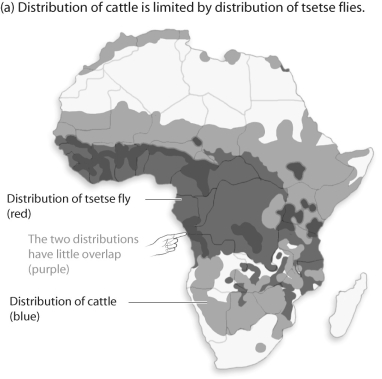
Based on Figure 50.4,and knowing what you know about cattle,what is the most logical conclusion?
A)Cattle distribution is primarily affected by temperature.
B)Tsetse flies somehow negatively affect cattle.
C)Cattle distribution is primarily affected by grass distribution.
D)Cattle somehow affect the reproduction of the tsetse fly.

Based on Figure 50.4,and knowing what you know about cattle,what is the most logical conclusion?
A)Cattle distribution is primarily affected by temperature.
B)Tsetse flies somehow negatively affect cattle.
C)Cattle distribution is primarily affected by grass distribution.
D)Cattle somehow affect the reproduction of the tsetse fly.

Unlock Deck
Unlock for access to all 38 flashcards in this deck.
Unlock Deck
k this deck
34
Use the following abstract from the International Journal of Climatology to answer the corresponding question(s).
Abstract:
The rainfall associated with the Indian summer monsoon shows large intraseasonal and interannual variability.Break-monsoon conditions are one of the important epochs of the monsoon,and they contribute significantly to the intraseasonal variability of the monsoon.The National Centers for Environmental Prediction-National Center for Atmospheric Research reanalysis data sets are used to investigate the significant energy budget terms during the pre-break (5 days prior to the commencement of the break),break and post-break (5 days after the cessation of the break)periods.In the present study,certain dynamic and thermodynamic characteristics of the monsoon circulation during break-monsoon conditions are investigated.The important terms in the various energy budget equations are analysed between the surface and 100 hPa for the break and its departures from pre- and post-break for the period 1968-96.The statistical significance of these departures is also examined by Student's t-test at the 95% confidence level.The volume integral of the budget terms is also examined in four sectors,i.e. ,the Arabian Sea,Bay of Bengal,northern India and central India.Significant changes in the wind field and vorticity at 850 hPa take place in the monsoon trough zone,coastal regions of the western coast of India and the southwestern Bay of Bengal of the southern Indian coast.The vertically upward rising arm of the Hadley cell weakens during the break phase.The strong flux convergence of kinetic energy in the central Arabian Sea and flux divergence in the northeastern Bay of Bengal weakens during pre- and post-break periods.Significant changes in the diabatic heating horizontal flux of heat and moisture are observed in the monsoon trough zone,central and northwestern Bay of Bengal.The Bay of Bengal and central India sectors show higher magnitudes and changes in respect of dynamic and thermodynamic parameters compared with the Arabian Sea and northern India.
Using the Bhatla et al.(2004)reference and your knowledge about the Hadley cell,would you expect a difference in thermodynamic parameters with monsoon magnitude and variability with latitude?
A)Yes
B)No
C)From the information given,it is impossible to tell if there will be a difference in thermodynamic parameters with monsoon magnitude and variability with latitude.
Abstract:
The rainfall associated with the Indian summer monsoon shows large intraseasonal and interannual variability.Break-monsoon conditions are one of the important epochs of the monsoon,and they contribute significantly to the intraseasonal variability of the monsoon.The National Centers for Environmental Prediction-National Center for Atmospheric Research reanalysis data sets are used to investigate the significant energy budget terms during the pre-break (5 days prior to the commencement of the break),break and post-break (5 days after the cessation of the break)periods.In the present study,certain dynamic and thermodynamic characteristics of the monsoon circulation during break-monsoon conditions are investigated.The important terms in the various energy budget equations are analysed between the surface and 100 hPa for the break and its departures from pre- and post-break for the period 1968-96.The statistical significance of these departures is also examined by Student's t-test at the 95% confidence level.The volume integral of the budget terms is also examined in four sectors,i.e. ,the Arabian Sea,Bay of Bengal,northern India and central India.Significant changes in the wind field and vorticity at 850 hPa take place in the monsoon trough zone,coastal regions of the western coast of India and the southwestern Bay of Bengal of the southern Indian coast.The vertically upward rising arm of the Hadley cell weakens during the break phase.The strong flux convergence of kinetic energy in the central Arabian Sea and flux divergence in the northeastern Bay of Bengal weakens during pre- and post-break periods.Significant changes in the diabatic heating horizontal flux of heat and moisture are observed in the monsoon trough zone,central and northwestern Bay of Bengal.The Bay of Bengal and central India sectors show higher magnitudes and changes in respect of dynamic and thermodynamic parameters compared with the Arabian Sea and northern India.
Using the Bhatla et al.(2004)reference and your knowledge about the Hadley cell,would you expect a difference in thermodynamic parameters with monsoon magnitude and variability with latitude?
A)Yes
B)No
C)From the information given,it is impossible to tell if there will be a difference in thermodynamic parameters with monsoon magnitude and variability with latitude.

Unlock Deck
Unlock for access to all 38 flashcards in this deck.
Unlock Deck
k this deck
35
For a species to be called "invasive," it must _____.
A)be introduced to a new area
B)spread rapidly in this new area
C)eliminate native species
D)be introduced to a new area and spread rapidly in this new area
E)be introduced to a new area,spread rapidly in this area,and eliminate native species
A)be introduced to a new area
B)spread rapidly in this new area
C)eliminate native species
D)be introduced to a new area and spread rapidly in this new area
E)be introduced to a new area,spread rapidly in this area,and eliminate native species

Unlock Deck
Unlock for access to all 38 flashcards in this deck.
Unlock Deck
k this deck
36
In which terrestrial area is global warming most likely to allow coniferous trees to encroach?
A)tropical wet forests
B)arctic tundra
C)temperate forests
D)boreal forests
A)tropical wet forests
B)arctic tundra
C)temperate forests
D)boreal forests

Unlock Deck
Unlock for access to all 38 flashcards in this deck.
Unlock Deck
k this deck
37
Besides sunlight,which would be the next most important climatic factors for plants?
A)wind and fire
B)moisture and wind
C)temperature and wind
D)temperature and moisture
A)wind and fire
B)moisture and wind
C)temperature and wind
D)temperature and moisture

Unlock Deck
Unlock for access to all 38 flashcards in this deck.
Unlock Deck
k this deck
38
Use the following abstract from the International Journal of Climatology to answer the corresponding question(s).
Abstract:
The rainfall associated with the Indian summer monsoon shows large intraseasonal and interannual variability.Break-monsoon conditions are one of the important epochs of the monsoon,and they contribute significantly to the intraseasonal variability of the monsoon.The National Centers for Environmental Prediction-National Center for Atmospheric Research reanalysis data sets are used to investigate the significant energy budget terms during the pre-break (5 days prior to the commencement of the break),break and post-break (5 days after the cessation of the break)periods.In the present study,certain dynamic and thermodynamic characteristics of the monsoon circulation during break-monsoon conditions are investigated.The important terms in the various energy budget equations are analysed between the surface and 100 hPa for the break and its departures from pre- and post-break for the period 1968-96.The statistical significance of these departures is also examined by Student's t-test at the 95% confidence level.The volume integral of the budget terms is also examined in four sectors,i.e. ,the Arabian Sea,Bay of Bengal,northern India and central India.Significant changes in the wind field and vorticity at 850 hPa take place in the monsoon trough zone,coastal regions of the western coast of India and the southwestern Bay of Bengal of the southern Indian coast.The vertically upward rising arm of the Hadley cell weakens during the break phase.The strong flux convergence of kinetic energy in the central Arabian Sea and flux divergence in the northeastern Bay of Bengal weakens during pre- and post-break periods.Significant changes in the diabatic heating horizontal flux of heat and moisture are observed in the monsoon trough zone,central and northwestern Bay of Bengal.The Bay of Bengal and central India sectors show higher magnitudes and changes in respect of dynamic and thermodynamic parameters compared with the Arabian Sea and northern India.
The rainfall associated with the Indian summer monsoon shows a large intraseasonal and interannual variability.Break-monsoon conditions are one of the most important epochs of the monsoon,and they contribute significantly to the intraseasonal variability of the monsoon.Given what you know about the Hadley cell,how would it have to change to produce this break phase in the monsoon (Bhatla et al. ,2004)?
A)The downward arm of Hadley cell strengthens.
B)The upward arm of Hadley cell strengthens.
C)The downward arm of Hadley cell weakens.
D)The upward arm of Hadley cell weakens.
E)No change is needed in the Hadley cell to produce the break phase.
Abstract:
The rainfall associated with the Indian summer monsoon shows large intraseasonal and interannual variability.Break-monsoon conditions are one of the important epochs of the monsoon,and they contribute significantly to the intraseasonal variability of the monsoon.The National Centers for Environmental Prediction-National Center for Atmospheric Research reanalysis data sets are used to investigate the significant energy budget terms during the pre-break (5 days prior to the commencement of the break),break and post-break (5 days after the cessation of the break)periods.In the present study,certain dynamic and thermodynamic characteristics of the monsoon circulation during break-monsoon conditions are investigated.The important terms in the various energy budget equations are analysed between the surface and 100 hPa for the break and its departures from pre- and post-break for the period 1968-96.The statistical significance of these departures is also examined by Student's t-test at the 95% confidence level.The volume integral of the budget terms is also examined in four sectors,i.e. ,the Arabian Sea,Bay of Bengal,northern India and central India.Significant changes in the wind field and vorticity at 850 hPa take place in the monsoon trough zone,coastal regions of the western coast of India and the southwestern Bay of Bengal of the southern Indian coast.The vertically upward rising arm of the Hadley cell weakens during the break phase.The strong flux convergence of kinetic energy in the central Arabian Sea and flux divergence in the northeastern Bay of Bengal weakens during pre- and post-break periods.Significant changes in the diabatic heating horizontal flux of heat and moisture are observed in the monsoon trough zone,central and northwestern Bay of Bengal.The Bay of Bengal and central India sectors show higher magnitudes and changes in respect of dynamic and thermodynamic parameters compared with the Arabian Sea and northern India.
The rainfall associated with the Indian summer monsoon shows a large intraseasonal and interannual variability.Break-monsoon conditions are one of the most important epochs of the monsoon,and they contribute significantly to the intraseasonal variability of the monsoon.Given what you know about the Hadley cell,how would it have to change to produce this break phase in the monsoon (Bhatla et al. ,2004)?
A)The downward arm of Hadley cell strengthens.
B)The upward arm of Hadley cell strengthens.
C)The downward arm of Hadley cell weakens.
D)The upward arm of Hadley cell weakens.
E)No change is needed in the Hadley cell to produce the break phase.

Unlock Deck
Unlock for access to all 38 flashcards in this deck.
Unlock Deck
k this deck



